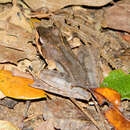Description
provided by AmphibiaWeb articles
M 39-48 mm, F 45-50 mm. Morphologically similar to G. luteus except for its larger body size, and especially the larger and more prominent femoral glands. Variation: Specimens from Antoetra have some genetic differentiation as compared to specimens from the Ranomafana area. Whether this reflects any relevant taxonomic divergence remains unstudied.Taken with permission from Glaw and Vences (2007).
Glaw, F. and Vences, M. (2008). Gephyromantis plicifer. In: IUCN 2008. 2008 IUCN Red List of Threatened Species. www.iucnredlist.org. Downloaded on 18 March 2009.
- author
- Miguel Vences
- author
- Frank Glaw
Distribution and Habitat
provided by AmphibiaWeb articles
Andohahela, Chaines Anosyennes, Midongy, Ranomafana.This species has been recorded from two localities at 400-900m (Glaw and Vences 2008).
- author
- Miguel Vences
- author
- Frank Glaw
Life History, Abundance, Activity, and Special Behaviors
provided by AmphibiaWeb articles
Habits: Males have been observed calling at night from the vegetation, ca. 50 cm above the ground, in rainforest. Calls: Single notes, or series of up to five notes, with a much slower note repetition rate than in G. luteus and G. sculpturatus. The notes are not melodious and quite clearly pulsed.
- author
- Miguel Vences
- author
- Frank Glaw
Life History, Abundance, Activity, and Special Behaviors
provided by AmphibiaWeb articles
This species is listed as near threatened because its Extent of Occurrence is probably not much greater than 20,000 km2, and the extent and quality of its habitat are probably declining, thus making the species close to qualifying for Vulnerable. It occurs in Parc National de Ranomafana, and perhaps in Parc National d’Andohahela, however, it is threatened by the loss and degradation of its forest habitat due to subsistence agriculture, timber extraction, charcoal manufacture, invasive spread of eucalyptus, livestock grazing and expanding human settlements (Glaw and Vences 2008).
- author
- Miguel Vences
- author
- Frank Glaw
Gephyromantis plicifer
provided by wikipedia EN
Gephyromantis plicifer, commonly known as the common Madagascar frog, is a species of frog in the family Mantellidae. It is endemic to Madagascar. Its natural habitat is subtropical or tropical moist lowland forests. It is threatened by habitat loss.
References

- license
- cc-by-sa-3.0
- copyright
- Wikipedia authors and editors
Gephyromantis plicifer: Brief Summary
provided by wikipedia EN
Gephyromantis plicifer, commonly known as the common Madagascar frog, is a species of frog in the family Mantellidae. It is endemic to Madagascar. Its natural habitat is subtropical or tropical moist lowland forests. It is threatened by habitat loss.
- license
- cc-by-sa-3.0
- copyright
- Wikipedia authors and editors

